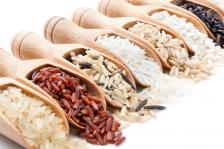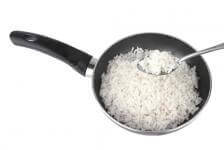Can Chilling Your Rice Cut Calories in Half?
Scientists announce a new way of cooking rice that could reduce calories by up to 60%. But this method may also increase your risk of food poisoning if you’re not careful. Nutrition Diva reports.
Monica Reinagel, MS, LD/N, CNS
Listen
Can Chilling Your Rice Cut Calories in Half?

This year, however, was different. A couple of scientists from Sri Lanka announced that they’d discovered a new method for cooking rice that could reduce calories by up to 60%. You would have thought they put men on Mars!
As usual, the headlines have gotten a little ahead of the science. So far, the scientists have only managed to reduce calories in rice by 10-15%. However, they speculate that using the same technique on other varieties of rice could eventually reduce calories by 50-60%. This has not yet been demonstrated. There’s also a very important safety concern that anyone attempting to replicate this effect at home needs to know about.
>
How Resistant Starch Cuts Calories
This story is about resistant starch, something I’ve talked about in previous Nutrition Diva episodes. As we already knew, cooking and cooling starchy foods like rice, pasta, and potatoes converts more of the starches they contain into a type of starch that is resistant to digestion. Reheating does not undo this effect.
See also: Why Leftover Pasta Is Good for You
Resistant starch acts more like fiber than starch. It passes through the digestive system largely undigested, thereby reducing the amount of calories that are absorbed. Resistant starch also acts as a prebiotic, supplying nutrients to our gut bacteria. So far, so good.
How to Enhance Resistant Starch in Rice

The researchers also used a method of preparing rice that is common in Asia but not so common in the West. Instead of steaming the rice for 15-20 minutes, the rice is boiled in water for 40 minutes and then dried in an oven. It’s not yet clear what effect those longer cooking times might have on resistant starch production.
How Long Does the Rice Need to Be Chilled?
The Sri Lankan team chilled the rice for 12 hours before testing the resistant starch content. It’s impossible to say from this study whether shorter cooling times would be equally effective. My educated guess is that most of the starch conversion happens in the first couple of hours. Again, further research will have to determine whether I’m right about that.
Finally, the amount of resistant starch in cooked rice varies enormously, depending on the variety of rice. (And there are an astonishing number of rice varieties out there. Apparently, there are 38 varieties commonly used in Sri Lanka alone!)

They expect that using the same technique on rice that is higher in resistant starch to begin with will be even more effective, perhaps even cutting calories in half. This, however, remains to be seen.
Although there are obviously still a lot of details to sort out, the two factors thought to be key to enhancing resistant starch production in rice are the addition of oil (about 1 teaspoon per 1/2 cup of uncooked rice) and chilling the rice after cooking it. And there’s no reason you can’t try this at home.
But before you do, there’s an important safety warning….
Improperly Cooled Rice Carries Food Poisoning Risk

See also: Why do I Get Food Poisoning When Others Don’t?
I have to admit that I’ve been improperly handling rice for my entire life – letting it slowly cool to room temperature in the pot before refrigerating leftovers – and have somehow lived to tell the tale. Indeed, food poisoning caused by Bacillus cereus is not very common; it’s responsible for only 2-5% of all cases of food poisoning. And, although unpleasant, it’s rarely severe enough to be life-threatening.
Nonetheless, I’m grateful to those Nutrition Diva listeners for educating me about this risk and I’ll be more careful from now on. The best way to cool hot rice is to spread it in a shallow pan, such as a casserole or baking sheet, where it will cool more quickly. As soon as it is luke warm (which shouldn’t take more than 5-10 minutes), pack it into an air-tight container and keep it in the fridge or freezer until you’re ready to eat it.

In other words, don’t start doubling your portion sizes on the grounds that the calories have been cut in half – because they probably haven’t. And make sure to chill that rice quickly in order to minimize the chances of illness.
Have you tried this cooling method of preparing rice? Share your thoughts with us in Comments below or on the Nutrition Diva Facebook page.

